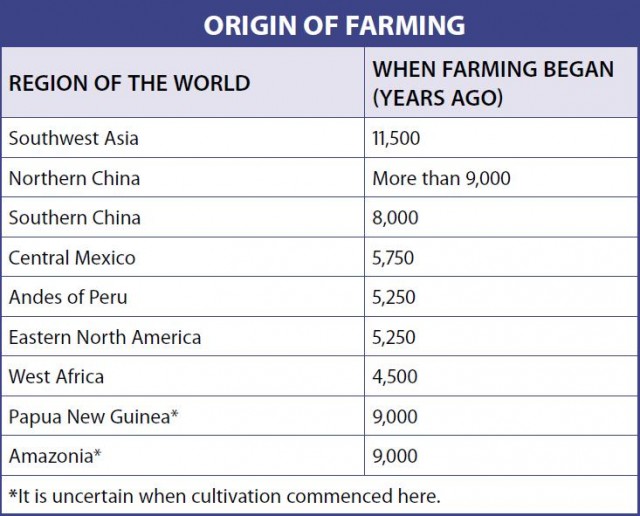The Origins of Agriculture
Life in a modern city or even a large town would be impossible were it not for the farmers who grow crops and the distribution and retailing systems that bring the food to the stores. It is agriculture that makes urban life possible, but it makes no sense to suggest that farming began in order to make it possible for people to live in cities. How could people have had any concept of cities in a world where none existed?
Originally, humans obtained their food by hunting, scavenging, fishing, and gathering edible plant materials such as fruits, roots, and leaves. In some places people manipulated their environment to encourage it to produce more food. They set fires to drive game into ambushes, and the fires also cleared away wilted and inedible plants, fertilized the soil with the ash, and produced new plant growth. In some places they weeded food-producing areas to remove inedible plants that competed with those yielding tasty, satisfying foods. People knew, of course, that plants grow from seeds, and there were—and are still, for instance in tropical South America—tribes who cleared patches of forest to make gardens in which they cultivated vegetables.
This was not agriculture, however. Agriculture is the cultivation of domesticated crop plants, especially the cereals that provide the basic ingredients in most diets. No one knows just why people gradually changed from hunting and gathering to farming. There have been many suggestions.
Some have proposed that the invention of farming was an inevitable consequence of cultural advance. Once a few people had discovered how crops might be cultivated, the superiority of farming over living on wild foods became evident. Farming would allow nomadic people to settle in one place and enjoy a higher standard of living with enhanced food security. They would have time to devote to art, craft, music, and intellectual debate. This seems unlikely, however. Most contemporary hunter-gatherers find their lives quite satisfactory. They do not necessarily have to devote more time to obtaining food than they would if they grew it, and most seem to enjoy plenty of leisure. They have a detailed knowledge of the plants and animals on which they depend and in some cases hunter-gatherers live close to agricultural communities and trade with them, without being tempted to change their way of life.
Perhaps, then, some combination of demographic and environmental change made hunting and gathering less dependable. Maybe a prolonged period of favorable conditions allowed populations to increase, and when conditions reverted to their former state the natural environment could no longer produce enough food for everyone and people were forced to start farming. That might be what happened, but there is a difficulty: In its early stages there is no guarantee that farming will increase food availability.
A more likely explanation is that no one set out to invent farming. It happened almost by itself when, over many generations, people selected those individual plants that best suited their needs. Spilled seeds from the chosen plants would have germinated, people would then have started to combine cultivation of some crops with the gathering of others, and in time cultivation would have come to provide most of the community's food. As people learned to grow crops, their selection of individual plants altered the characteristics of the crop species until farming communities and their crops were inseparable. Whatever the reasons for it, crop cultivation arose independently in many parts of the world, and archaeologists know approximately when this happened. The following table lists the regions where farming began, and when.

Although scientists are uncertain when cultivation began in Amazonia, there is overwhelming evidence that for centuries prior to the arrival of Europeans much of what is now lowland rain forest was farmed. William Denevan, a professor emeritus at the University of Wisconsin, Madison, devoted many years to the study of this region and has written extensively on the farming that was once practiced there. There are the remains of what were once fields. Some fields were raised to improve drainage. Others were worked into ridges and furrows; crops would have been sown along the ridges. There were fields worked into scattered raised areas and fields with ditches to remove surplus water. The soils were also changed. The Amazonian farmers treated them with charcoal and possibly composted wastes. These treatments blackened the soils, so they are quite unlike other soils in the region. These relics of former farms cover a large area, and it is likely that until a few centuries ago farms covered a substantial part of what is now forest. Far from having existed for thousands or even millions of years, these Amazonian forests are no more than about 500 years old. The farmers would have been able to support villages with a combined population in the hundreds of thousands.